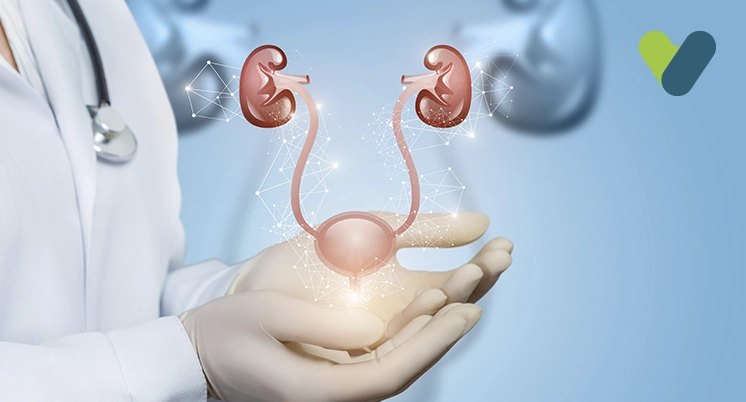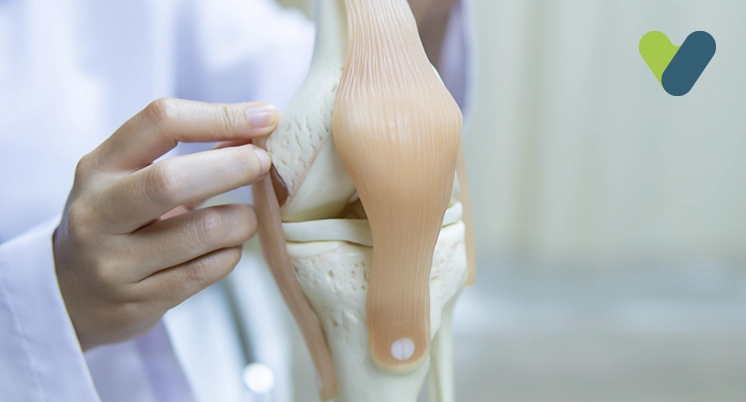What is partial knee replacement surgery?
Partial knee replacement surgery (also referred to as unicompartmental knee replacement surgery) is a surgical treatment procedure that substitutes a part of a damaged knee with plastic and metal materials known as implants or prostheses. It can be used to replace the inside (medial) or outside (lateral) part of the knee as well as the kneecap (patella).
Partial knee replacement surgery serves as an alternative treatment option for total knee replacement surgery in individuals with advanced osteoarthritis where the damage is limited to one part of the knee. It is also recommended for patients with joint diseases caused by rheumatoid arthritis, moderate knee deformity, or post-traumatic arthritis.
A surgeon will evaluate the knee joint's mobility, stability, and strength to determine if a knee replacement is an appropriate option. X-rays may be taken to help determine the severity of the damage.
Patients' weight, age, level of activity, knee shape, size, and overall health are important determinants of the best prosthesis (artificial joints) and surgical treatment for them. Since a partial knee replacement operation is done through a relatively small incision, patients typically spend fewer days in the hospital and return to their daily activities earlier compared to total knee replacement patients.
Who is the right candidate for a partial knee replacement operation or surgery?
People suffering from lateral or medial knee osteoarthritis may be suitable candidates for partial knee replacement surgery. The term 'medial' pertains to the inside part of the joint that is closest to the other knee, whereas 'lateral' pertains to the outer part away from the other knee. The most common arthritis deformity is medial knee joint degeneration.
Other factors to take into account to decice who needs this surgery include the following:
- If the pain in the knee persists even after taking pain-relieving medications and staying at an ideal weight, one may need to consider a knee replacement.
- A practitioner will advise patients to figure out the cause of their knee pain, and then, assess the range of movement and knee stability. The eligibility for a provisional knee replacement will be determined using an X-ray of the knee; however, until the surgery begins, the surgeon may not know for certain whether the patient is a suitable candidate.
- A sufficient range of knee movements, damage to only one knee component, an intact anterior cruciate ligament, and a stable knee are all required to qualify for this surgery. The deformity's angulation is also taken into account. Advanced unicompartmental knee replacements have shown outstanding medium- and long-term outcomes in both younger and older patients with proper patient selection.
Why is partial knee resurfacing surgery done?
The most likely reason for a knee replacement procedure is to relieve arthritis pain. People who require knee replacement surgery frequently have difficulty climbing stairs, walking, and getting out of chairs.
Perhaps if only one component of the knee is compromised or damaged, surgeons can often replace just that portion, but if the whole joint necessities replacement, the shinbone and thighbone ends are reshaped, and the joint is resurfaced. These bones are like hard tubes that have a soft centre. The artificial parts' ends are implanted into this softer central part.
Ligaments are tissue bands that help stabilise joints. If the ligaments in the knee are not strong enough to keep the joint together on their own, the surgeon may opt for implants that can be connected so they do not come apart.
What are the risks associated with partial knee replacement surgery?
Knee replacement surgery, just like any other procedure, has risks. They are as follows:
- Infection: Infection at the site of the incision or in deeper tissue can occur after surgery. In some cases, surgery is required to address an infection.
- Blood clot: To avoid this risk, surgeons usually suggest blood-thinning medications. The leg is the most common site for blood clots; they can, however, reach the lungs and be fatal.
- Damage to the nerves: Nerves in the vicinity of the implant can get damaged during the surgery, resulting in numbness, pain, and weakness.
- Injury to adjoining healthy tissues: Harm to the surrounding healthy cartilages and ligaments of the knee joint may occur during unicompartmental knee replacement surgery, while fitting implants, or during tissue wear and tear.
Knee replacement implants are long-lasting, but they can become loose or worn over time. If this occurs, another surgery for replacing the worn or loose parts may be required.
Pre-operative preparation for the partial knee replacement surgery
Certain things, such as medications taken without a doctor's prescription, substances to which one is allergic, and current medications and drugs the patient is taking, must be disclosed to the doctor. The following are a few points to keep in mind during the pre-operative preparation phase:
- Inquire with the orthopaedist about medications one can take on the day of the surgical procedure. The doctor will advise them on which medications must be stopped.
- If someone has diabetes, a heart condition, or has suffered from a major illness, they must notify their doctor.
- Smoking should be strictly avoided because it slows recovery and prolongs the healing process.
- One should also notify the doctor if they consume alcohol regularly (more than 1 to 2 drinks per day).
- If the patient gets a cold, flu, herpes, or any other illness before their surgery, notify the orthopaedic surgeon.
- Prepare home so as to make it a little more spacious. It will be easy to move around after surgery. Try walking with aids such as wheelchairs, canes, crutches, and walkers. This will make the post-recovery day-to-day activities much easy.
The day before the partial knee replacement surgery
Vital signs such as pulse rate, body temperature, and blood pressure are all checked the day before surgery. A blood test may be performed to check for any infection and to determine the blood count. If the blood count is low, the patient may need to plan for a blood transfusion to replenish the loss of blood during the partial knee replacement surgical operation.
The day of the surgical procedure
On the day of the procedure:- The patient should not drink or eat anything for at minimum 6 hours before the surgery. The doctor will tell them for how long they should fast.
- One must take the medications prescribed by the orthopaedic surgeon.
- The patient must show up at the doctor's office or hospital at the specified time.
Partial knee replacement surgery methods and techniques
A partial knee replacement is a hospital procedure, which means that the patient must stay in the hospital for a few days after the surgery. The anaesthesiologist will administer general anaesthesia to make the patient unconscious during the surgical procedure. The patient is monitored closely throughout the surgical procedure to reduce risks and complications.
The following is a technique for partial (unicompartmental) knee replacement surgery:
- A orthopaedic surgeon will first thoroughly examine the knee joint and start making a cut (incision) on the front portion of the joint. Through this incision, the surgeon can assess all three components and approach the damaged compartment of the knee joint.
- Damaged cartilage and bone fragments of the knee joint are removed from the affected compartment by using special saws. The removed portion is then substituted with a metal covering to recreate the joint's surface.
- Cement is used to retain these metal implants in place.
- A plastic insert or covering is placed between two metal components to reduce friction and create a smooth gliding surface, which is usually the function of cartilage.
- Stitches are then used to close the skin and wound.
Following the surgery, the patient would be shifted to the recovery room and closely monitored by a panel of orthopaedics and nurses.
Following the surgical procedure
After partial knee replacement surgery, the patient will need to be admitted to the hospital for a day or two. Though nurses will monitor patients at the hospital, they must take very good care of themself when they are discharged. The following list of guidelines will assist them in recovering quickly after surgery.
- Follow-up appointments: Follow-up appointments must be adhered to strictly. These appointments assist the orthopaedic surgeon in evaluating the overall result of the surgery and identifying any flaws that may have occurred during the procedure. In addition, follow-ups help the patients know how well they are recovering. The orthopaedist might give them some guidance to aid in fast recovery.
- Moving around: Understandably, moving around will be challenging and uncomfortable in the first few days after surgery. Patients should make an effort to do some light exercise each day, such as slow walking for a few minutes. They can use a walking stick or walker to assist in walking. After about a month, they may be able to walk without assistance. Patients can gradually increase their stamina and choose more vigorous exercises such as swimming, fast walking, biking, tennis, and golf. Exercising helps strengthen the muscle tissue around the knees while also increasing the range of motion; however, make sure to apply less pressure to the surgically repaired knee.
- Seek the assistance of a physiotherapist: In order to recover quickly, patients should seek the help and support of a physiotherapist. A physiotherapist can assist them with certain exercises that will increase knee joint mobility while also easing knee joint pain. One can recover quickly with the appropriate assistance and guidance of their physiotherapist. The physical therapist will not only assist them in increasing their willpower to heal and recover but will also provide them with help and push them through this difficult period.
- Diet: The relevance of diet during the recovery phase cannot be overstated. Because the patient has undergone a major surgical procedure, they must consume a high-protein diet to compensate for muscle loss and a calcium-rich diet to strengthen their bones. Proteins are body-building blocks that aid in forming muscles and tissues. The body cannot produce tissues without proteins, which will eventually slow down your recovery. Protein-rich foods involve chicken, eggs, dals, and lentils.
Calcium is yet another nutrient that is necessary for the formation of strong bones. Our bodies absorb calcium highly effectively when it is combined with vitamin D. The sun is the best source of vitamin D. Exposure to adequate sunlight aids in the conversion of vitamin D from its inactive form to its active form. Milk, yoghurt, kale, watercress, sardines, cheese, and broccoli are some of the common calcium-rich foods that are available.
What is the cost of a partial knee replacement in India?
Typically, the partial knee replacement cost in India varies among hospitals and centres, depending on a variety of factors.Important factors influencing the overall price include:
- Diagnostic tests and consultation fee
- Type of Surgical Procedure
- The admission fees
- patient's medical condition and age
- Hospital type and room selected
- City
Takeaway Partial knee replacement surgery is a minimally invasive procedure used to treat damage in one compartment of the knee joint. It has certain benefits, including less pain and a shorter recovery time; however, not everyone is a good candidate, and there are potential risks and complications associated with the procedure. Above all, it can provide significant relief and improve the quality of life for eligible patients. It is best to discuss with your orthopaedic surgeon the best suitability for the procedure and the estimated costs of the procedure.


